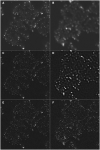SEM3De: image restoration for FIB-SEM
- PMID: 37745005
- PMCID: PMC10516526
- DOI: 10.1093/bioadv/vbad119
SEM3De: image restoration for FIB-SEM
Abstract
Motivation: FIB-SEM (Focused Ion Beam-Scanning Electron Microscopy) is a technique to generate 3D images of samples up to several microns in depth. The principle is based on the alternate use of SEM to image the surface of the sample (a few nanometers thickness) and of FIB to mill the surface of the sample a few nanometers at the time. In this way, huge stacks of images can thus be acquired.Although this technique has proven useful in imaging biological systems, the presence of some visual artifacts (stripes due to sample milling, detector saturation, charge effects, focus or sample drift, etc.) still raises some challenges for image interpretation and analyses.
Results: With the aim of meeting these challenges, we developed a freeware (SEM3De) that either corrects artifacts with state-of-the-art approaches or, when artifacts are impossible to correct, enables the replacement of artifactual slices by an in-painted image created from adjacent non-artifactual slices. Thus, SEM3De improves the overall usability of FIB-SEM acquisitions.
Availability and implementation: SEM3De can be downloaded from https://sourceforge.net/projects/sem3de/ as a plugin for ImageJ.
© The Author(s) 2023. Published by Oxford University Press.
Conflict of interest statement
None declared.
Figures

References
-
- Adelson E, Anderson CH, Bergen JR et al.Pyramid methods in image processing. RCA Eng 1984;29:33–41.
-
- Bertalmío M, Caselles V, Masnou S et al.Inpainting. In: Ikeuchi K (ed.), Computer Vision. Boston, MA: Springer, 2014, 401–416. 10.1007/978-0-387-31439-6_249 - DOI
-
- Buyssens P, Daisy M, Tschumperle D. et al. Exemplar-based inpainting: technical review and new heuristics for better geometric reconstructions. IEEE Trans Image Process 2015;24:1809–24. - PubMed
-
- Demir U, Ünal G. Patch-based image inpainting with generative adversarial networks. arXiv, https://arxiv.org/abs/1803.07422, 2018, preprint: not peer reviewed.
-
- Fernandez J-J, Torres TE, Martin-Solana E. et al. PolishEM: image enhancement in FIB–SEM. Bioinformatics 2020;36:3947–8. - PubMed
LinkOut - more resources
Full Text Sources

